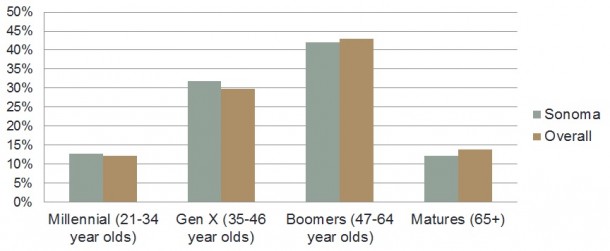We commonly hear on the Internet and across various media and analyst sites that Millennials (21 – 34 years old) are driving fine wine sales.
Not so.
According to Silicon Valley Bank’s Rob McMillan (an informative guy to follow if you like to stay up to speed on wine industry trends), this is not true. He calls it the “Millennial Myth.”
From this market update on the “SVB on Wine” blog, he notes:
“What is true is the Millennials have the highest growth rate, but like all segments with low numbers of consumers, the high growth is because of the small base versus the growth in the nominal consumption of the segment.”
McMillan implores wineries to adjust not only marketing budgets depending on what segment of the market they are targeting, but also to think about the distinction between “willingness” and “capacity” to buy. A twenty-something might have the willingness to buy that 2001 Silver Oak Cab, but do they have the capacity?
In other words, don’t market to people who can’t afford your product.

Boomers are the wealthiest generation. But for marketers, at least of wine, there’s a paradox. “The problem,” writes McMillan, “is the older generation doesn’t have the willingness – or maybe the kidneys – to be a dominant cohort in wine sales.”
So if the Millennials have the willingness, but not the capacity, and if the reverse is true for Boomers, what to do?
The answer is not necessarily black and white, or “binary.” Referring to the famous Boston Consulting Group matrix (the one they used to tape to our foreheads in MBA school) is a good place to start; it provides a classic (if not overly simplistic) way to frame discussion around target markets:
Obviously the path to sales is different for each business (or winery) so there’s no universal edict. For wineries, however, McMillan believes that Gen X represents the best growth opportunity. That doesn’t mean ignoring other demographics. Far from it. Rather, the approach needs to be properly aligned. For boomers, who “have the highest market share in wine purchases still,” that means “milking” the segment (and how odd does that sound?). One suggestion: low alcohol wines – in an effort to extend the length of time the segment will be interested in your product. McMillan’s Mom can “nurse a large bottle of moscato for a month.” Whatever tactics are employed, he suggests spending less vigorously on Gen X.
Wine is a fickle business. It will be interesting to see how the market evolves over the coming years. Growth in the U.S. has been something fierce over the last few decades. It’s fair to say even that our wine culture has somewhat matured. We no longer buy based purely on price, or purely on a score. We’re more likely to listen to peers, to social media. Though Millennials might not be driving fine wine sales today, they will assuredly come another decade or two. For now, sell them the wine equivalent of a BMW 1-series, and build brand loyalty as soon as possible. And, yes, I’m quite certain all of this is easier said than done!


